DiSC Customer Styles: Selling to the Different Personality Types

Many of us—without thinking about it—play up or play down parts of our personalities around different people. You might be more open and animated with one friend, and more private and steady with another. Likewise, no matter what type of salesperson you are, you can stretch toward the styles of your customers to create deeper connections and increase sales. It starts with using DiSC® to understand selling to the different personality types.
Key Takeaways
- Salespeople can enhance their effectiveness by adapting their selling style to match their customers’ buying styles.
- By observing customers’ behaviors, salespeople can estimate their DiSC styles and tailor their approach accordingly. Fast-paced and outspoken customers may have D or i tendencies, while cautious and reflective customers may lean towards S or C styles.
- The DiSC model encourages salespeople to be flexible and curious about their customers’ priorities, allowing them to stretch beyond their natural tendencies and build stronger relationships.
- Salespeople should be sincere, well-prepared, and responsive to their customers’ needs and preferences. This will create deeper connections and generate more sales.
Practice people-reading
You’re not likely to know the DiSC styles of your customers, but you can practice people-reading to estimate where they might fall on the DiSC map. Think about one of your customers and their observable behaviors. Are they more fast-paced and outspoken or cautious and reflective? Are they more questioning and skeptical or accepting and warm?
- Fast-paced and outspoken + questioning and skeptical = D-style tendencies
- Fast-paced and outspoken + accepting and warm = i-style tendencies
- Cautious and reflective + accepting and warm = S-style tendencies
- Cautious and reflective + questioning and skeptical = C-style tendencies
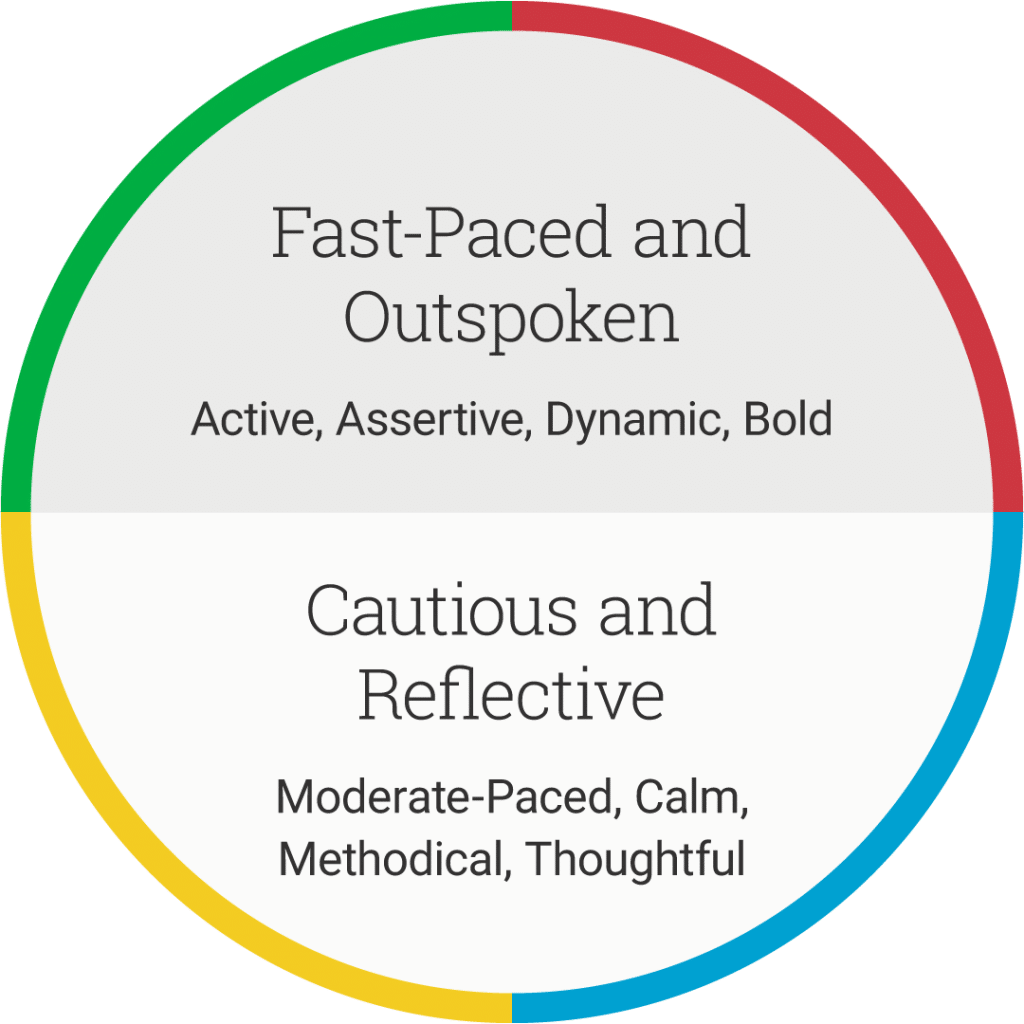
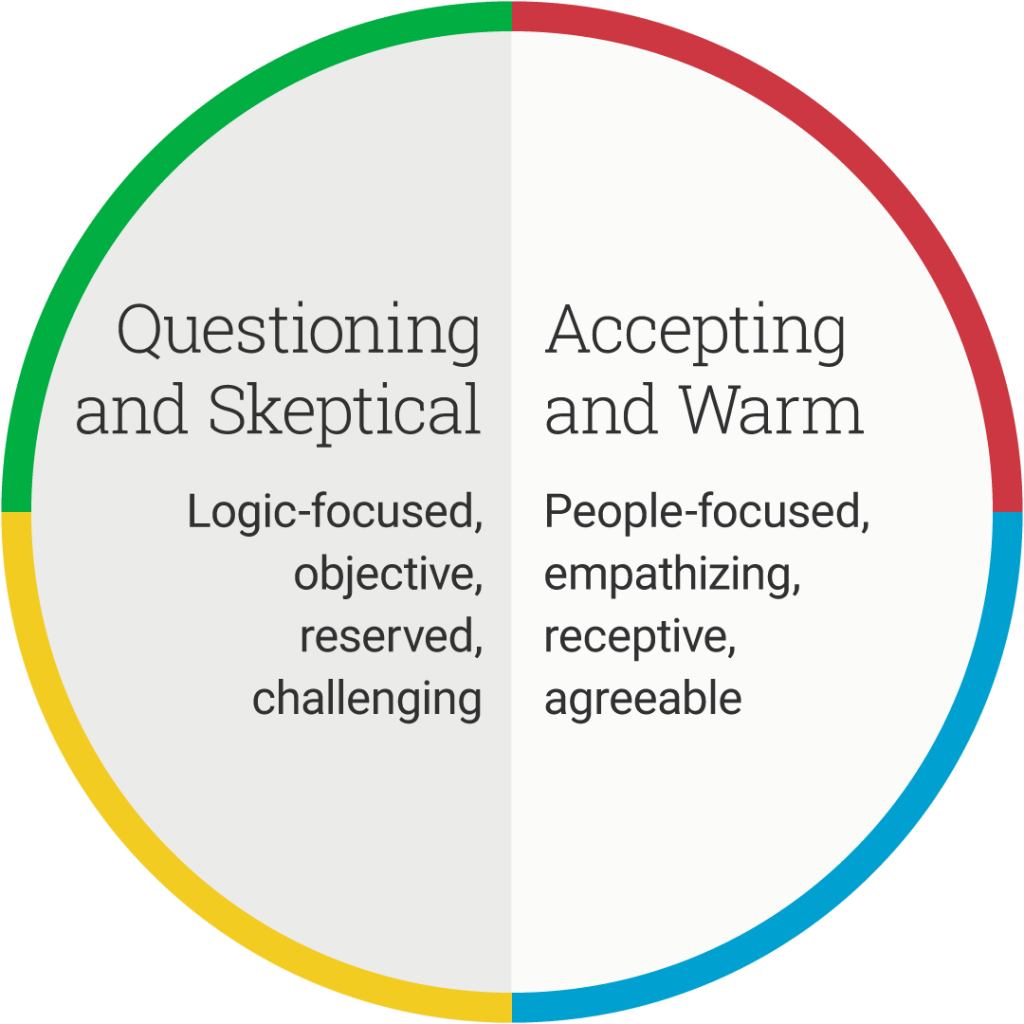
Once you have mapped a customer, continue reading below to learn how their priorities might differ from your own in sales interactions. (The Everything DiSC® Sales profile goes into much more detail, with advice personalized to you and your style.) Understanding where your customers are coming from lets you lean into behaviors that will build effective relationships with them. As leadership expert Robin Sharma says, “take care of your relationships and the money will take care of itself.”
D-style customers
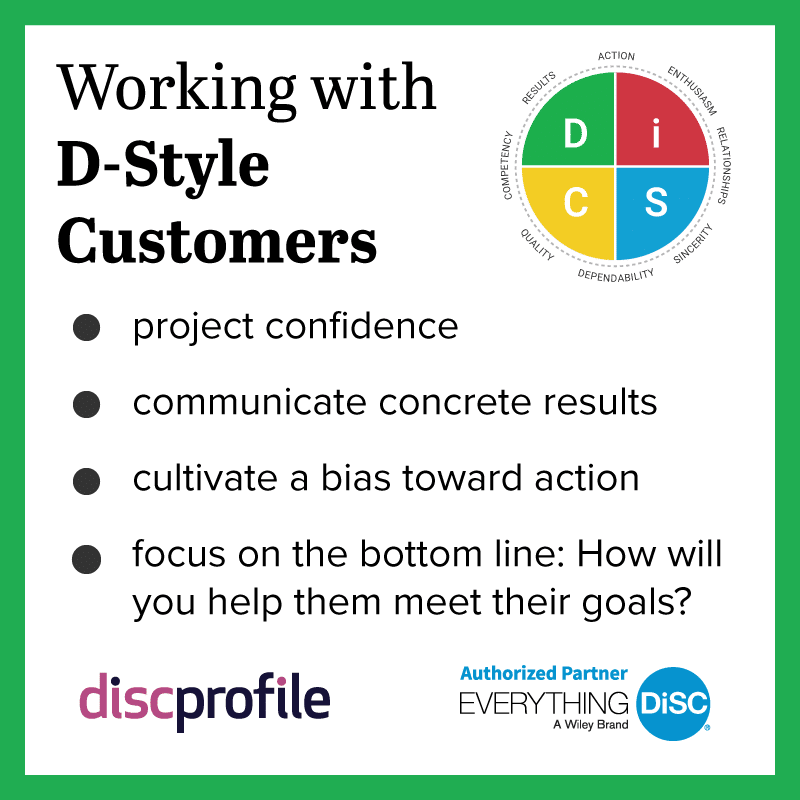
Priorities: Results, action, competency
D-style customers know what they want and make quick decisions. They have a take-charge attitude and are usually not afraid to express their opinions.
Recognizing the D buying style
During sales interactions, a D-style customer will often:
- Move at a fast pace
- Desire immediate results
- Be willing to think big and take risks
- Speak candidly and assertively
What D-style customers want from a salesperson
D-style customers are goal-oriented. How will you help them achieve success? Start there. When selling to D-style individuals, you often don’t need a lot of warm-up talk before getting to the real meat of the conversation. Here’s how to connect with customers who display D-style tendencies:
- Project confidence and determination.
- Show them you are competent.
- Focus on the bottom line and their return on investment.
- Communicate the concrete results and immediate developments they can expect.
- Cultivate a bias toward action.
Our D-style staff member
i-style customers
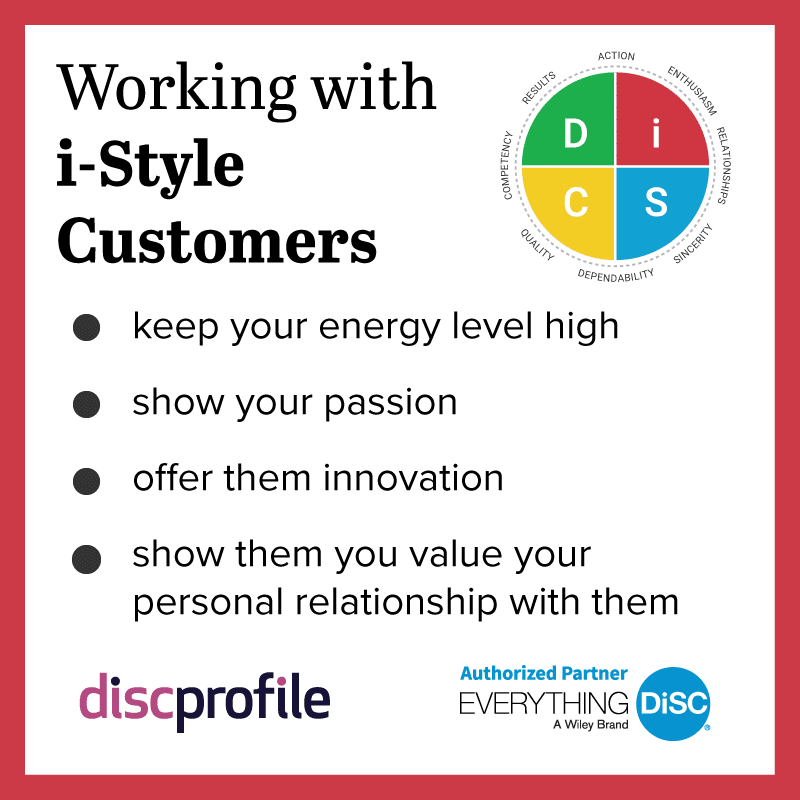
Priorities: Enthusiasm, relationships, action
Customers who tend toward the i style are extroverted and optimistic. They enjoy the social aspect of sales interactions and look for a friendly, informal atmosphere.
Recognizing the i buying style
To identify i-style customers, look for:
- Energy and optimism
- Reliance on intuition
- Consideration of others’ feelings and maintaining relationships
- Willingness to move fast and try new ideas
What i-style customers want from a salesperson
To connect with customers who display i-style traits, think of your interactions within the context of an ongoing relationship. Take time to build trust through friendly and sincere conversation. Also:
- Keep your energy level high. Inspire and excite them.
- Focus on what makes you passionate about your product or service, rather than more practical considerations (you can get to those later, if needed).
- Offer them innovation. Customers with the i style are often willing to be the first to try something new or to take an exciting but promising risk.
- Show them that you value your personal relationship with them. Be open and willing to share some details about your life if that’s where they take the conversation. It can be harder for i-style individuals to trust people who are all business all the time.
Our iD-style staff member
Our iS-style staff member
S-style customers
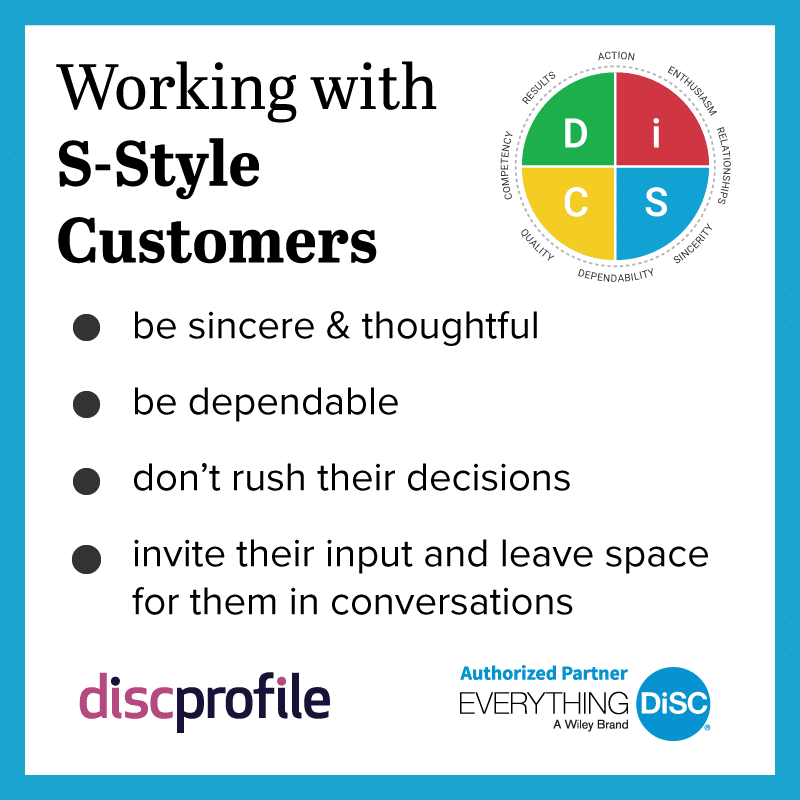
Priorities: Sincerity, dependability, relationships
S-style customers are often soft-spoken and agreeable. They are careful decision-makers, wanting to be absolutely sure their choice is right before they commit.
Recognizing the S buying style
To recognize an S-style customer, look for:
- An even temper
- Patient listening skills
- Displays of modesty and accommodation
- Hesitancy to commit to decisions
What S-style customers want from a salesperson
No matter your style, you can build a good relationship with S-style customers if you show them you are genuine and trustworthy. To better connect with S-style customers:
- Be sincere.
- Display thoughtfulness. Let them know you care about them beyond the sale.
- Earn their trust.
- Show them they can depend on you long term.
- Give them the time they need to think through their decision.
- Leave space for them in the conversation. S-style individuals can be very accommodating, making it easy for you to dominate the discussion. Don’t take their silence as agreement—ask questions and invite their input.
Our SC-style staff member
C-style customers
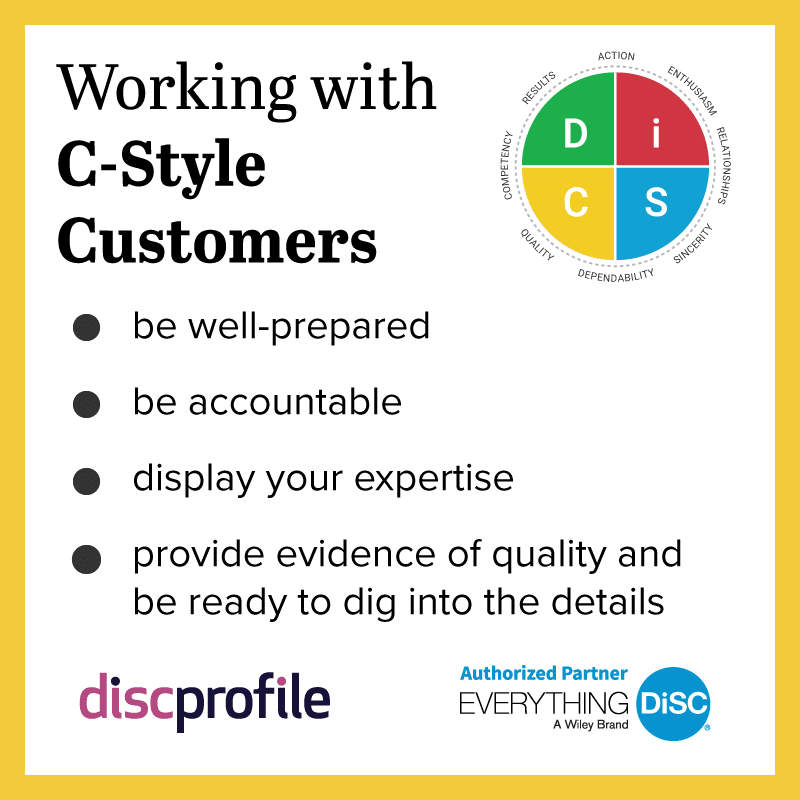
Priorities: Quality, competency, dependability
People with C styles tend to approach buying decisions in systematic and analytical ways. They want to stick to the facts rather than straying into personal discussions.
Recognizing the C buying style
With C-style customers, you may notice:
- Methodical pace
- Interest in details
- Priority on logic and reason
- Private, reserved nature
What C-style customers want from a salesperson
If you’re working with a customer who displays C-style tendencies, you can build a relationship with them by emphasizing your own competency and your product’s high quality. Here are some other tips for connecting with C-style customers:
- Be well-prepared. These customers will likely have detailed questions, so have your answers ready.
- Dig deeper. While other customers may prefer the big picture, C-style customers often like to learn about details. Follow their lead and be willing to get into the weeds with them.
- Provide evidence of quality. C-style customers are generally skeptical and won’t be wooed by a catchy tagline. How can you demonstrate the merit of what you offer?
- Be accountable. Follow through on your promises and don’t promise more than you can deliver.
- Display your expertise. This is not the time for style over substance. Present yourself as the expert you are.
Our CD-style staff member
Stretch to connect
Everything DiSC Sales is an assessment and learning experience that helps any customer-facing team have better interactions with customers. The 25-page report provides detailed—and thoroughly personalized—guidance on people-reading and building relationships with all types of customers.
The DiSC model does not limit you to the behaviors most common to your style. On the contrary: DiSC teaches you how understanding your natural tendencies allows you to stretch into other mindsets depending on who you’re interacting with. Every person is a mix of all DiSC styles, even if they are strongly inclined to their own. We are all capable of flexing into any part of the DiSC map. When salespeople understand this—and get curious about the priorities of their customers—they are able to make deeper connections. “Don’t celebrate closing a sale,” says Patricia Fripp, “celebrate opening a relationship.”
Buying priorities: DiSC customer styles in action
Customers' buying priorities reflect their DiSC styles. If you can identify the things that truly matter to your customers when they're making a big purchase, both through people-reading and through open conversation, you can tailor your sales presentations to their needs.

A perfect example of DiSC buying priorities in action can be found in the DiSCprofile.com parking lot. A few years ago, our team noticed there were four new vehicles in our parking lot: a Lexus CT200 hybrid, a MINI CooperS Countryman, a Ford F-150 SuperCab truck, and a Honda CRV. Once we started talking about our vehicle purchases, we discovered that our DiSC priorities were obvious in our choices and in how we made those purchases.
The D priority
The Lexus was obviously bought by Nancy, who has a D style. She wanted status and results. She liked her current Lexus but wanted better mileage, so she went directly to the dealership. She asked the salesman about performance and luxury options. “I wanted to drive the car right away, so I drove off before learning how to work everything.” Yes, the D style can be impatient. “I couldn’t immediately get Sirius radio to work or get traffic reports. I need that.” So she called the dealer to get things working right.
The i priority
Shelly, who has an i style, bought the MINI Cooper. No run-of-the-mill car for her. She wanted a car that was sporty to drive, less common in her area, and that matched her energetic personality. Shelly’s salesperson knew to make her feel comfortable, treat her as though she was special, and move quickly through the buying process. After the purchase, her salesperson walked her through the car’s features including the music system. They got off track talking about features and chatted about music instead. The car Shelly liked didn’t have racing stripes, so she made sure those were added.
The S priority
Our S-style staff member, Tim, bought a Honda CRV. He bought a vehicle knowing he was going to keep it for a long time. He wanted reliability and looked for safety features. He included his whole family in the purchase process. Tim didn’t want to negotiate on price; he was more comfortable deciding on a vehicle and buying at the posted price. No high-pressure sales technique for Tim; just leave him to talk with his family. He did want the sales rep to be available to answer questions but to otherwise give him space. Tim wanted his salesperson to be genuine, have a sense of humor, and not take himself too seriously.
The C priority
Kristeen has a C style, and she started looking at trucks weeks before she was ready to buy. Her first trip to a dealership was to look at just the front seats of trucks to determine what she liked best. The salesman who wanted to talk about leather versus fabric and other options turned her off. She wanted her specific questions answered and that was it. Only after she had read various websites and forums, considered all the option packages, selected the exact truck she wanted, and identified the only dealer in the area who had it did she go in to make the purchase. She dismissed the offer to run through the controls with the declaration, “I’ll read the manual.” And, of course, she did.
Posted 04/15/2022, Last Updated 01/27/2025







